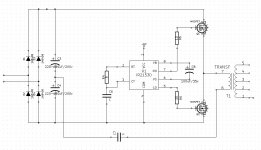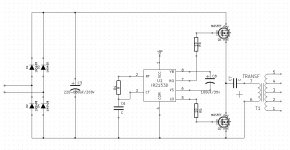I was going through some simple SMPS circuits based on IRS2153D and came across a few variations. Most commonly the output MOSFETs are coupled to the transformer as shown in fig-1. Can't we make it simpler as shown in fig-2?
Note: This circuit uses mains voltage (and voltage doubler for 120v) so that the DC rail will be around 340v. This schematic is primarily conceptual, so capacitor values and voltage ratings will vary depending on specific requirement.
Thanks!
Note that there is an error in the schematic (but I can't edit pictures), PIN-6 of IR2153 should be connected to the MOSFET output.
Note: This circuit uses mains voltage (and voltage doubler for 120v) so that the DC rail will be around 340v. This schematic is primarily conceptual, so capacitor values and voltage ratings will vary depending on specific requirement.
Thanks!
Note that there is an error in the schematic (but I can't edit pictures), PIN-6 of IR2153 should be connected to the MOSFET output.
Attachments
Last edited:
With a jumper option the one on the left can be a 120/220 cct.
The one on the right cannot operate the same way.
Good point. Can't we just get rid of C7 in that case, and directly connect that wire?
Yes, you can connect directly in the first circuit.
But C7 can be quite useful to tune the whole circuit to an LLC-converter!
With clock frequency adjusted to the upper, series resonance of the LLC tank, this gives you less losses and lowest output impedance without the need for a regulating loop.
Pracitically this requires a transformer with very poor coupling.
But C7 can be quite useful to tune the whole circuit to an LLC-converter!
With clock frequency adjusted to the upper, series resonance of the LLC tank, this gives you less losses and lowest output impedance without the need for a regulating loop.
Pracitically this requires a transformer with very poor coupling.
Yes, you can connect directly in the first circuit.
But C7 can be quite useful to tune the whole circuit to an LLC-converter!
With clock frequency adjusted to the upper, series resonance of the LLC tank, this gives you less losses and lowest output impedance without the need for a regulating loop.
Pracitically this requires a transformer with very poor coupling.
For LLC I usually wind the secondary next to the primary instead of on top of it. I separate the windings with a tie wrap.
Original circuit I saw had 20+20 turns on the primary, but used the standard input voltage doubler configuration. In order to make this to work with 120v with no voltage doubling, can we just make input 10+10 turns?
Should be OK.
I use quad-filar (4 strands) windings for the current.
Power Integrations makes several all in one SMPS off line products. They also have on line design tools.
Power Integrations offers a range of power conversion ICs that can provide reliable, efficient, low cost power solutions for audio power applications. Capable of supporting peak power requirements in excess of three times average power requirements with no increase in transformer size, the PeakSwitch™ product family is ideal for supporting applications with large peak loads, such as:
Audio amplifiers
Computer audio
Home theater
MP3 music players
MP3 audio systems
Digital radio applications
Welcome To Power Integrations | Power Integrations
Power Integrations offers a range of power conversion ICs that can provide reliable, efficient, low cost power solutions for audio power applications. Capable of supporting peak power requirements in excess of three times average power requirements with no increase in transformer size, the PeakSwitch™ product family is ideal for supporting applications with large peak loads, such as:
Audio amplifiers
Computer audio
Home theater
MP3 music players
MP3 audio systems
Digital radio applications
Welcome To Power Integrations | Power Integrations
Whichever of the two circuit to be built
there must be a fast recovery diode between pin 1
& pin 8..even data sheet recommend it..
Regards,
Kikodemy
As per the data sheet, IR2153D has a built-in diode. Typical Connections schematic in the data sheet clarifies that.
Last edited:
- Status
- This old topic is closed. If you want to reopen this topic, contact a moderator using the "Report Post" button.
- Home
- Amplifiers
- Power Supplies
- Can't we make SMPS simpler?

